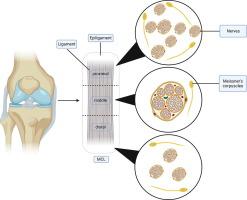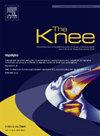揭示内侧副韧带脱毛的感觉结构:具有临床意义的形态学研究
IF 2
4区 医学
Q3 ORTHOPEDICS
引用次数: 0
摘要
本尸体描述性研究旨在评估人类膝关节内侧副韧带(MCL)脱毛的神经纤维和机械感受器-它们的分布,密度和潜在的临床意义。方法取材于12具新鲜尸体,分别用苏木精、伊红、Luxol耐晒蓝/甲酚紫、S100B抗体和髓鞘碱性蛋白抗体对其近、中、远3个部位的5 μm切片进行染色。采用方差分析和事后Tukey检验来评估毛发不同部位神经元件密度分布的差异。结果脱毛近端区有髓和无髓神经纤维及迈斯纳小体密度最高,远端区次之,而中端区尽管密度较低,但含有较大口径的神经纤维,这表明初级神经分支从中端进入,随后向近端和远端区分支成较小的纤维。结论本研究首次证实了MCL脱毛内存在迈斯纳小体,从而扩大了我们对韧带机械感受的理解。这些发现强调了脱毛在调节机械感受、伤害感觉、本体感觉和血流调节中的关键作用,并强调了其对韧带再生和术后结果的潜在影响。总的来说,我们的研究推进了当前对MCL神经支配的认识,并为未来研究其在膝关节生物力学和韧带愈合中的治疗意义奠定了基础。本文章由计算机程序翻译,如有差异,请以英文原文为准。

Unveiling the sensory architecture of the medial collateral ligament epiligament: A morphological study with clinical relevance
Background
This cadaveric descriptive study was aimed at evaluation of the nerve fibers and mechanoreceptors of the epiligament of the medial collateral ligament (MCL) of the human knee – their distribution, density and potential clinical implications.
Methods
Tissue samples were obtained from 12 fresh cadavers, and 5-μm sections corresponding to the proximal, mid, and distal portions of the epiligament were stained with hematoxylin and eosin, Luxol fast blue/Cresyl violet, and antibodies against S100B and myelin basic protein. ANOVA and post hoc Tukey tests were used to assess the differences in density distributions of the neural elements in the different portions of the epiligament.
Results
The proximal region of the epiligament exhibited the highest density of both myelinated and unmyelinated nerve fibers and Meissner’s corpuscles, followed by the distal region, while the mid-portion, despite a lower density, contained larger-caliber nerve fibers –suggesting that primary nerve branches enter through the mid-region and subsequently branch into smaller fibers towards the proximal and distal areas.
Conclusions
This investigation is the first to document the presence of Meissner’s corpuscles within the epiligament of the MCL, thereby expanding our understanding of ligament mechanoreception. These findings underscore the pivotal role of the epiligament in mediating mechanoreception, nociception, proprioception, and blood flow regulation, and highlight its potential impact on ligament regeneration and post-surgical outcomes. Overall, our study advances the current knowledge of MCL innervation and lays the groundwork for future research into its therapeutic implications in knee joint biomechanics and ligament healing.
求助全文
通过发布文献求助,成功后即可免费获取论文全文。
去求助
来源期刊

Knee
医学-外科
CiteScore
3.80
自引率
5.30%
发文量
171
审稿时长
6 months
期刊介绍:
The Knee is an international journal publishing studies on the clinical treatment and fundamental biomechanical characteristics of this joint. The aim of the journal is to provide a vehicle relevant to surgeons, biomedical engineers, imaging specialists, materials scientists, rehabilitation personnel and all those with an interest in the knee.
The topics covered include, but are not limited to:
• Anatomy, physiology, morphology and biochemistry;
• Biomechanical studies;
• Advances in the development of prosthetic, orthotic and augmentation devices;
• Imaging and diagnostic techniques;
• Pathology;
• Trauma;
• Surgery;
• Rehabilitation.
 求助内容:
求助内容: 应助结果提醒方式:
应助结果提醒方式:


